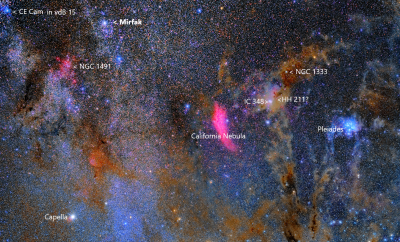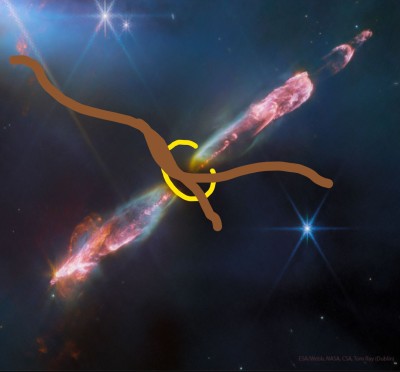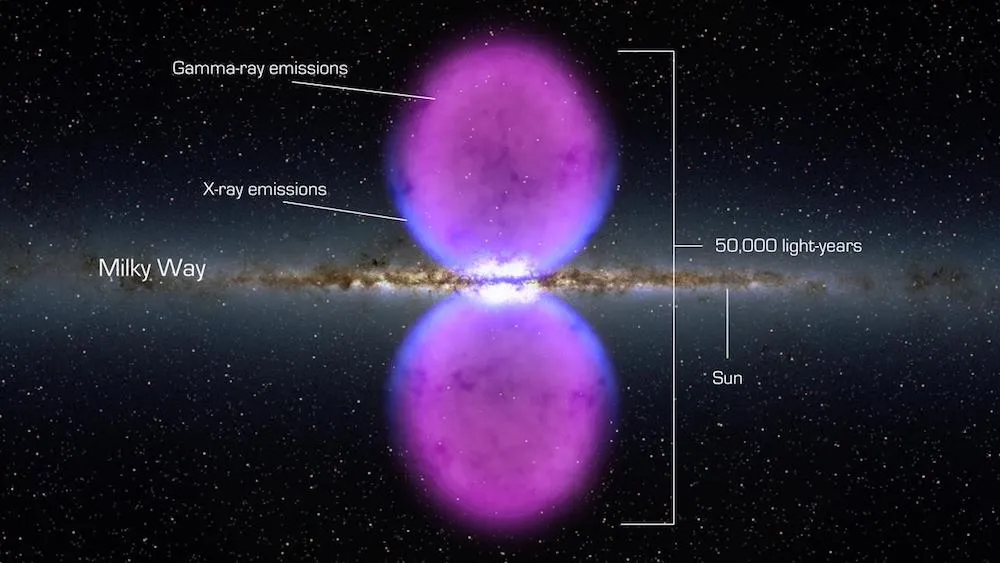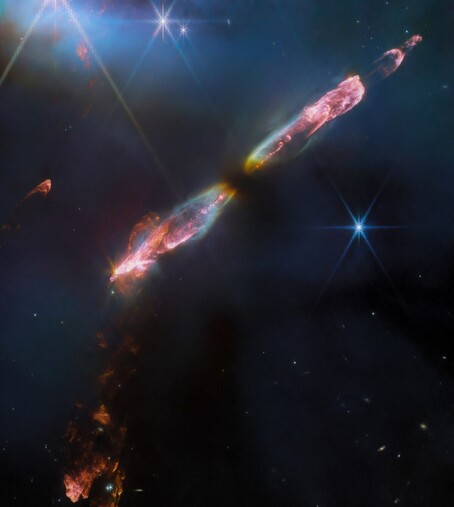Page 1 of 1
APOD: HH 211: Jets from a Forming Star (2023 Sep 19)
Posted: Tue Sep 19, 2023 4:07 am
by APOD Robot
 HH 211: Jets from a Forming Star
Explanation:
HH 211: Jets from a Forming Star
Explanation: Do
stars always create jets as they form? No one is sure. As a gas cloud
gravitationally contracts, it forms a
disk that can spin too fast to continue contracting into a
protostar. Theorists
hypothesize that this spin can be reduced by expelling jets. This speculation coincides with known
Herbig-Haro (HH) objects, young stellar objects seen to emit jets -- sometimes in
spectacular fashion.
Pictured is Herbig-Haro 211, a young star in formation
recently imaged by the
Webb Space Telescope (JWST) in
infrared light and in
great detail. Along with the
two narrow beams of particles, red
shock waves can be seen as the outflows impact
existing interstellar gas. The jets of
HH 221 will likely change shape as they brighten and fade over the next 100,000 years, as research into the details of
star formation continues.
Re: APOD: HH 211: Jets from a Forming Star (2023 Sep 19)
Posted: Tue Sep 19, 2023 6:28 am
by Ann
Nice image. Screamingly obvious false color. I don't have much to say about it - I'll leave most of that to the rest of you - but do note the "waist", the dust disk, the disk where planets will be forming. The star itself is hidden underneath all that dust.
So where is HH 211 located?
I found a stunning wide field image centered on Perseus, which reveals both stars and amazing details of many light-year-long strands of dust. Here you find both the Pleiades,
NGC 1333,
IC 348, the Flame Nebula, Capella, Mirfak,
NGC 1491 and CE Cam (
in reflection nebula vdB 15).
And hopefully I have managed to show you the approximate position of HH211, the star of today's APOD. Do note the fantastic long arcs of gas and dust in the picture!
Perseus molecular cloud, HH211, stars and nebulas.
Image credit: Matt Dieterich.
Do look at
the full size of Matt Dieterich's image. It's amazing!
Ann
Re: APOD: HH 211: Jets from a Forming Star (2023 Sep 19)
Posted: Tue Sep 19, 2023 8:32 am
by FLPhotoCatcher
Why are there extra lobes of the jet in the upper-right?
Re: APOD: HH 211: Jets from a Forming Star (2023 Sep 19)
Posted: Tue Sep 19, 2023 9:50 am
by JohnD
FLPhotoCatcher wrote: ↑Tue Sep 19, 2023 8:32 am
Why are there extra lobes of the jet in the upper-right?
Intermittent jetting? If you click on the "hypothesize" link, you can read the abstract about just this. In which I love the use, in a serious astrophysics paper, of the term "wiggle"!
And just to orientate us, Ann has explained that the protostar is in the middle, where she circled (?)
Are these jets polar, axial to the disc's rotation?
John
Re: APOD: HH 211: Jets from a Forming Star (2023 Sep 19)
Posted: Tue Sep 19, 2023 11:01 am
by Ann
JohnD wrote: ↑Tue Sep 19, 2023 9:50 am
FLPhotoCatcher wrote: ↑Tue Sep 19, 2023 8:32 am
Why are there extra lobes of the jet in the upper-right?
Intermittent jetting? If you click on the "hypothesize" link, you can read the abstract about just this. In which I love the use, in a serious astrophysics paper, of the term "wiggle"!
And just to orientate us, Ann has explained that the protostar is in the middle, where she circled (?)
Are these jets polar, axial to the disc's rotation?
John
I think they are polar! Lotsa weird stuff is polar! Even the Milky Way is doing some weird polar stuff!
Ann
Re: APOD: HH 211: Jets from a Forming Star (2023 Sep 19)
Posted: Tue Sep 19, 2023 11:13 am
by Knight of Clear Skies
Ann wrote: ↑Tue Sep 19, 2023 6:28 am
And hopefully I have managed to show you the approximate position of HH211, the star of today's APOD. Do note the fantastic long arcs of gas and dust in the picture!
Think you've got it right Ann. It's part of the mostly hidden IC348 complex which is best viewed in infra-red:
http://viewer.legacysurvey.org/?ra=56.0 ... eo6&zoom=9
Re: APOD: HH 211: Jets from a Forming Star (2023 Sep 19)
Posted: Tue Sep 19, 2023 12:50 pm
by Pat H
I thought JWST IR could see through dust clouds ?
Maybe some one could provide a brief explanation.
Thank you,
Pat
( I don't know anything about astronomy ... 'just enjoy the photos. )
Re: APOD: HH 211: Jets from a Forming Star (2023 Sep 19)
Posted: Tue Sep 19, 2023 1:50 pm
by Christian G.
Not sure where I read this nor if I understood correctly, but by hitting the surrounding gas those jets would render it unsuitable to form other nearby stars and as a result the protostar keeps it all to itself to feed on and grow. Like some stellar darwinism!
Re: APOD: HH 211: Jets from a Forming Star (2023 Sep 19)
Posted: Tue Sep 19, 2023 2:32 pm
by Ann
Pat H wrote: ↑Tue Sep 19, 2023 12:50 pm
I thought JWST IR could see through dust clouds ?
Maybe some one could provide a brief explanation.
Thank you,
Pat
( I don't know anything about astronomy ... 'just enjoy the photos. )
Well, today's APOD is a
NIRCam image. NIRCam is sensitive to near infrared light, from 0.6 to 5 microns.
MIRI, the other JWST instrument, is sensitive to mid-infrared light at 5 to 28 microns.
You may compare a
MIRI image of Stephan's Quintet with a
NIRCam/MIRI composite of Stephan's Quintet.
It is certainly possible that MIRI would be able to see right through the dust disk that is hiding the star in today's NIRCam image. But I, for mine, am not convinced.
Ann
Re: APOD: HH 211: Jets from a Forming Star (2023 Sep 19)
Posted: Tue Sep 19, 2023 4:42 pm
by orin stepanek
HH221 Jets are just spectacular!

Great APOD with great photos!
Kitty watches intently!
Re: APOD: HH 211: Jets from a Forming Star (2023 Sep 19)
Posted: Wed Sep 20, 2023 11:41 am
by AVAO
Ann wrote: ↑Tue Sep 19, 2023 6:28 am
So where is HH 211 located?
I found a stunning wide field image centered on Perseus, which reveals both stars and amazing details of many light-year-long strands of dust. Here you find both the Pleiades,
NGC 1333,
IC 348, the Flame Nebula, Capella, Mirfak,
NGC 1491 and CE Cam (
in reflection nebula vdB 15).
And hopefully I have managed to show you the approximate position of HH211, the star of today's APOD. Do note the fantastic long arcs of gas and dust in the picture!

Do look at
the full size of Matt Dieterich's image. It's amazing!
Ann
ThanX Ann
Your positioning is definitely correct. The JWST has chosen the most exciting area in the star formation region IC 348. Similar to NGC 1333 (
viewtopic.php?t=43077&sid=8d74b6c90f6c8 ... 8a#p330476), it is teeming with young stars, all of which are in the HH phase. Apparently the jets are currently all aligned so that they don't destroy each other, although these are superimposed in today's APOD. What is surprising to me is that there seems to be a mutual exchange between the cantilevered dust arms of the accretion disks.
Jac
biggg: https://live.staticflickr.com/65535/532 ... 897c_o.jpg
jac berne (flickr) DSS2 red / AllWISE MidIR / JWST Nircam
STScI Image: ESA/Webb, NASA, CSA, T. Ray
https://files.mastodon.social/cache/med ... f87bed.png
Copyright: Yuval Harpaz
Re: APOD: HH 211: Jets from a Forming Star (2023 Sep 19)
Posted: Wed Sep 20, 2023 1:37 pm
by Ann
AVAO wrote: ↑Wed Sep 20, 2023 11:41 am
Ann wrote: ↑Tue Sep 19, 2023 6:28 am
So where is HH 211 located?
I found a stunning wide field image centered on Perseus, which reveals both stars and amazing details of many light-year-long strands of dust. Here you find both the Pleiades,
NGC 1333,
IC 348, the Flame Nebula, Capella, Mirfak,
NGC 1491 and CE Cam (
in reflection nebula vdB 15).
And hopefully I have managed to show you the approximate position of HH211, the star of today's APOD. Do note the fantastic long arcs of gas and dust in the picture!

Do look at
the full size of Matt Dieterich's image. It's amazing!
Ann
ThanX Ann
Your positioning is definitely correct. The JWST has chosen the most exciting area in the star formation region IC 348. Similar to NGC 1333 (
viewtopic.php?t=43077&sid=8d74b6c90f6c8 ... 8a#p330476), it is teeming with young stars, all of which are in the HH phase. Apparently the jets are currently all aligned so that they don't destroy each other, although these are superimposed in today's APOD. What is surprising to me is that there seems to be a mutual exchange between the cantilevered dust arms of the accretion disks.
Jac
biggg:
https://live.staticflickr.com/65535/532 ... 897c_o.jpg
jac berne (flickr)
Amazing, Jac! Thank you!
Ann
Re: APOD: HH 211: Jets from a Forming Star (2023 Sep 19)
Posted: Wed Sep 20, 2023 3:59 pm
by johnnydeep
AVAO wrote: ↑Wed Sep 20, 2023 11:41 am
Ann wrote: ↑Tue Sep 19, 2023 6:28 am
So where is HH 211 located?
...
Ann
ThanX Ann
Your positioning is definitely correct. The JWST has chosen the most exciting area in the star formation region IC 348. Similar to NGC 1333 (
viewtopic.php?t=43077&sid=8d74b6c90f6c8 ... 8a#p330476), it is teeming with young stars, all of which are in the HH phase. Apparently the jets are currently all aligned so that they don't destroy each other, although these are superimposed in today's APOD. What is surprising to me is that there seems to be a mutual exchange between the cantilevered dust arms of the accretion disks.
Jac
biggg: https://live.staticflickr.com/65535/532 ... 897c_o.jpg
jac berne (flickr) DSS2 red / AllWISE MidIR / JWST Nircam
STScI Image: ESA/Webb, NASA, CSA, T. Ray
9ecdfc930cf87bed[1].png
https://files.mastodon.social/cache/med ... f87bed.png
Copyright: Yuval Harpaz
Which cantilevered dust arms of which accretion disks?
Re: APOD: HH 211: Jets from a Forming Star (2023 Sep 19)
Posted: Thu Sep 21, 2023 4:47 am
by AVAO
johnnydeep wrote: ↑Wed Sep 20, 2023 3:59 pm
AVAO wrote: ↑Wed Sep 20, 2023 11:41 am
Ann wrote: ↑Tue Sep 19, 2023 6:28 am
So where is HH 211 located?
...
Ann
ThanX Ann
Your positioning is definitely correct. The JWST has chosen the most exciting area in the star formation region IC 348. Similar to NGC 1333 (
viewtopic.php?t=43077&sid=8d74b6c90f6c8 ... 8a#p330476), it is teeming with young stars, all of which are in the HH phase. Apparently the jets are currently all aligned so that they don't destroy each other, although these are superimposed in today's APOD. What is surprising to me is that there seems to be a mutual exchange between the cantilevered dust arms of the accretion disks.
Jac
biggg: https://live.staticflickr.com/65535/532 ... 897c_o.jpg
jac berne (flickr) DSS2 red / AllWISE MidIR / JWST Nircam
STScI Image: ESA/Webb, NASA, CSA, T. Ray
9ecdfc930cf87bed[1].png
https://files.mastodon.social/cache/med ... f87bed.png
Copyright: Yuval Harpaz
Which cantilevered dust arms of which accretion disks?
In today's apod you can see dark brown clouds of dust against a dark "blue" background (gas and very thinly distributed dust). If you look at the scene from further away, you get the impression that actual "dust rivers" exist between the young HH stars, which supply the accretion disks with new material or allow them to form in the first place. However, this is nothing more than a hypothesis. Today's APOD only confirmed to me that this could be correct.
HH-222: The Waterfall Nebula Source: http://annesastronomynews.com compare APOD 2011 October 24 https://apod.nasa.gov/apod/ap111024.html
Image Credit: Z. Levay (STScI/AURA/NASA), T.A. Rector (U. Alaska Anchorage) & H. Schweiker (NOAO/AURA/NSF), KPNO, NOAO
Google Bard (AI):
Accretion disks form in Herbig-Haro objects when a young star attracts material from a surrounding cloud of dust and gas. The cloud is collapsed by the star's gravity, and the material accumulates in a disk around the star.
The exact way in which accretion disks form in Herbig-Haro objects is not yet fully understood. One possibility is that the disk is created by the turbulence in the dust and gas cloud. The turbulence causes the material in the cloud to swirl around and eventually collect in a disk around the star. Another possibility is that the disk is formed by the rotation of the star. The rotation causes the material in the cloud to deflect along the star's rotation axis. When the material then hits the star, it slows down and forms a disk. Regardless of the exact form of formation, it is clear that the accretion disks of Herbig-Haro objects play an important role in the development of young stars. The material in the disk is eventually absorbed by the star and serves as fuel for stellar fusion. Here is a more detailed overview of the formation mechanisms of accretion disks in Herbig-Haro objects:
Turbulence mechanism: In the turbulence mechanism, the accretion disk is created by the turbulence in the dust and gas cloud. The turbulence causes the material in the cloud to swirl around and eventually collect in a disk around the star.
The turbulence can be caused by various factors such as: B. by the gravity of the star, by the movement of the cloud or by collisions between cloud fragments.
Rotation mechanism: In the rotation mechanism, the accretion disk is created by the rotation of the star. The rotation causes the material in the cloud to deflect along the star's rotation axis. When the material then hits the star, it slows down and forms a disk. The star's rotation is generated by the accretion of material from the cloud. The more material the star attracts, the faster it rotates.
Mixed model: It is likely that both mechanisms are involved in the formation of accretion disks in Herbig-Haro objects. The turbulence mechanism is probably responsible for the formation of the initial disk, while the rotation mechanism is responsible for the further development of the disk.
Re: APOD: HH 211: Jets from a Forming Star (2023 Sep 19)
Posted: Thu Sep 21, 2023 2:19 pm
by johnnydeep
AVAO wrote: ↑Thu Sep 21, 2023 4:47 am
johnnydeep wrote: ↑Wed Sep 20, 2023 3:59 pm
AVAO wrote: ↑Wed Sep 20, 2023 11:41 am
ThanX Ann
Your positioning is definitely correct. The JWST has chosen the most exciting area in the star formation region IC 348. Similar to NGC 1333 (
viewtopic.php?t=43077&sid=8d74b6c90f6c8 ... 8a#p330476), it is teeming with young stars, all of which are in the HH phase. Apparently the jets are currently all aligned so that they don't destroy each other, although these are superimposed in today's APOD. What is surprising to me is that there seems to be a mutual exchange between the cantilevered dust arms of the accretion disks.
Jac
biggg: https://live.staticflickr.com/65535/532 ... 897c_o.jpg
jac berne (flickr) DSS2 red / AllWISE MidIR / JWST Nircam
STScI Image: ESA/Webb, NASA, CSA, T. Ray
9ecdfc930cf87bed[1].png
https://files.mastodon.social/cache/med ... f87bed.png
Copyright: Yuval Harpaz
Which cantilevered dust arms of which accretion disks?
In today's apod you can see dark brown clouds of dust against a dark "blue" background (gas and very thinly distributed dust). If you look at the scene from further away, you get the impression that actual "dust rivers" exist between the young HH stars, which supply the accretion disks with new material or allow them to form in the first place. However, this is nothing more than a hypothesis. Today's APOD only confirmed to me that this could be correct.
HH-222: The Waterfall Nebula Source: http://annesastronomynews.com compare APOD 2011 October 24 https://apod.nasa.gov/apod/ap111024.html
Image Credit: Z. Levay (STScI/AURA/NASA), T.A. Rector (U. Alaska Anchorage) & H. Schweiker (NOAO/AURA/NSF), KPNO, NOAO
Google Bard (AI):
Accretion disks form in Herbig-Haro objects when a young star attracts material from a surrounding cloud of dust and gas. The cloud is collapsed by the star's gravity, and the material accumulates in a disk around the star.
The exact way in which accretion disks form in Herbig-Haro objects is not yet fully understood. One possibility is that the disk is created by the turbulence in the dust and gas cloud. The turbulence causes the material in the cloud to swirl around and eventually collect in a disk around the star. Another possibility is that the disk is formed by the rotation of the star. The rotation causes the material in the cloud to deflect along the star's rotation axis. When the material then hits the star, it slows down and forms a disk. Regardless of the exact form of formation, it is clear that the accretion disks of Herbig-Haro objects play an important role in the development of young stars. The material in the disk is eventually absorbed by the star and serves as fuel for stellar fusion. Here is a more detailed overview of the formation mechanisms of accretion disks in Herbig-Haro objects:
Turbulence mechanism: In the turbulence mechanism, the accretion disk is created by the turbulence in the dust and gas cloud. The turbulence causes the material in the cloud to swirl around and eventually collect in a disk around the star.
The turbulence can be caused by various factors such as: B. by the gravity of the star, by the movement of the cloud or by collisions between cloud fragments.
Rotation mechanism: In the rotation mechanism, the accretion disk is created by the rotation of the star. The rotation causes the material in the cloud to deflect along the star's rotation axis. When the material then hits the star, it slows down and forms a disk. The star's rotation is generated by the accretion of material from the cloud. The more material the star attracts, the faster it rotates.
Mixed model: It is likely that both mechanisms are involved in the formation of accretion disks in Herbig-Haro objects. The turbulence mechanism is probably responsible for the formation of the initial disk, while the rotation mechanism is responsible for the further development of the disk.
Alright. So would you call this part a "dust river" in today's APOD? - river in brown, accretion disk in yellow:
Re: APOD: HH 211: Jets from a Forming Star (2023 Sep 19)
Posted: Thu Sep 21, 2023 9:19 pm
by AVAO
AVAO wrote: ↑Thu Sep 21, 2023 4:47 am
johnnydeep wrote: ↑Thu Sep 21, 2023 2:19 pm
Which cantilevered dust arms of which accretion disks?
In today's apod you can see dark brown clouds of dust against a dark "blue" background (gas and very thinly distributed dust). If you look at the scene from further away, you get the impression that actual "dust rivers" exist between the young HH stars, which supply the accretion disks with new material or allow them to form in the first place. However, this is nothing more than a hypothesis. Today's APOD only confirmed to me that this could be correct.
HH-222: The Waterfall Nebula Source: http://annesastronomynews.com compare APOD 2011 October 24 https://apod.nasa.gov/apod/ap111024.html
Image Credit: Z. Levay (STScI/AURA/NASA), T.A. Rector (U. Alaska Anchorage) & H. Schweiker (NOAO/AURA/NSF), KPNO, NOAO
...
Alright. So would you call this part a "dust river" in today's APOD? - river in brown, accretion disk in yellow:

Exactly. Thanks for the visualisation!
Re: APOD: HH 211: Jets from a Forming Star (2023 Sep 19)
Posted: Tue Sep 26, 2023 3:36 am
by Guest
Would our pretty, little Sol have had jets? Would they have "frozen out" to form icy blobs at the distance of the Oort Cloud? Could they have contributed to the zone of comets?
Sol is actually one of the bigger, hotter stars in the Galaxy so perhaps she cooked off anything resembling residue from her jets?
Or could the heliosphere have some residuals from them?
 HH 211: Jets from a Forming Star
HH 211: Jets from a Forming Star






